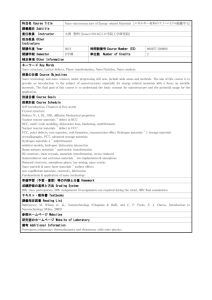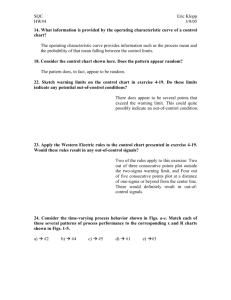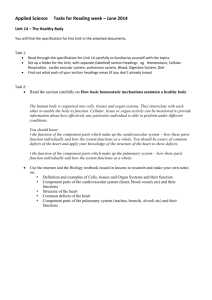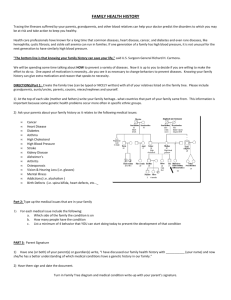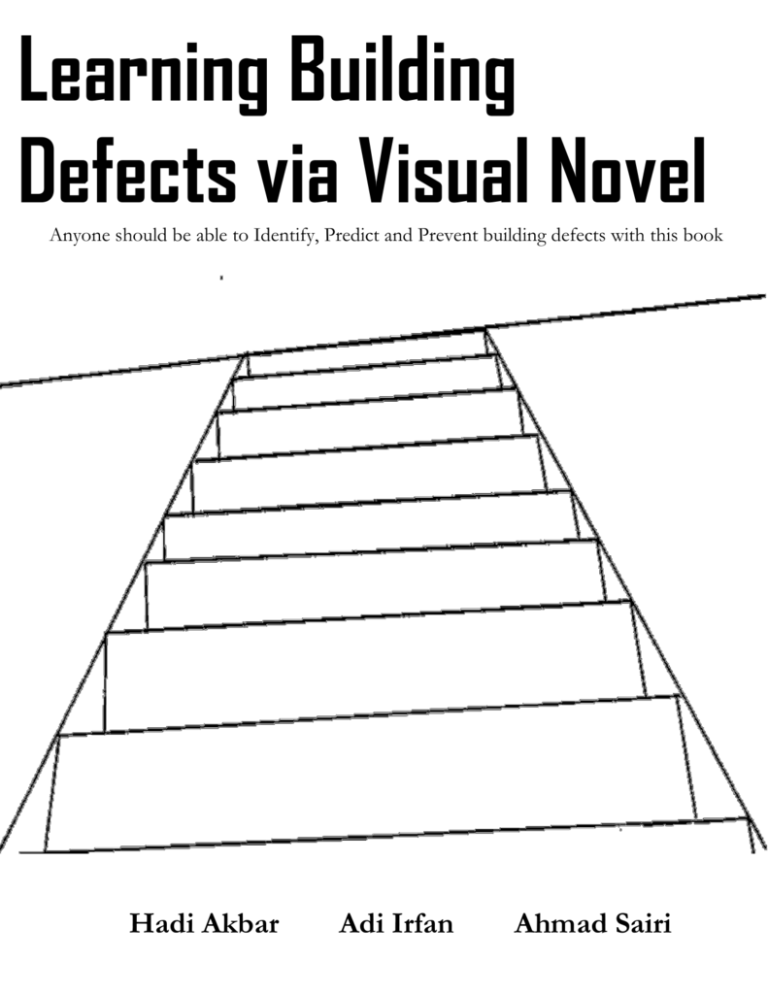
Learning Building
Defects via Visual Novel
Anyone should be able to Identify, Predict and Prevent building defects with this book
Hadi Akbar
Adi Irfan
Ahmad Sairi
Learning Building Defects via Visual
Novel Approach
Visual Interpreter
(BC0002815-A)
Cetakan 2014
Hakcipta / Copyright Kumpulan Rekabentuk Lestari
Universiti Kebangsaan Malaysia
Hak cipta terpelihara. Tiada bahagian daripada terbitan ini boleh diterbitkan semula,
disimpan untuk pengeluaran atau ditukarkan kedalam sebarang bentuk atau dengan
sebarang alat jugapun, sama dengan cara elektronik, gambar serta rakaman dan
sebagainya tanpa kebenaran bertulis dari Kumpulan Rekabentuk Lestari, Universiti
Kebangsaan Malaysia
All right reserved. No part of this publication may be reproduced or transmitted in any form or by any
means, electronics or
mechanical including photocopy, recording, or any information storage and retrieval system, without prior
permission in writing from the Kumpulan Rekabentuk Lestari, Universiti Kebangsaan Malaysia
Diterbitkan di Malaysia oleh / Published in Malaysia by
KUMPULAN REKABENTUK LESTARI
Universiti Kebangsaan Malaysia
43600 Bangi, Selangor, MALAYSIA
Dicetak di Malaysia oleh / Printed in Malaysia by
Penerbit UKM
Universiti Kebangsaan Malaysia
TABLE OF CONTENT
INTRODUCTION ...................................................................................................5
FUNDAMENTAL OF BUILDING SURVEY ........................................................................6
INTERMISSION: THE FIRST BUILDING CODE ..................................................................... 18
DAMPNESS .............................................................................................................. 19
INTERMISSION:THE LIVING BRIDGE OF CHERRAPUNJI ......................................................... 37
ROOF ....................................................................................................................... 38
INTERMISSION:BAM-I-DUNIAH .................................................................................... 56
WALL ..................................................................................................................... 57
INTERMISSION:THE WALL THAT SEPARATE A NATION ........................................................ 73
FLOOR ..................................................................................................................... 74
INTERMISSION:STANDING ON WATER ............................................................................ 87
INTERPRETING CRACKS ............................................................................................ 88
INTERMISSION:THE GREAT MOSQUE OF DJENNÉ.............................................................. 96
PROTECTING YOURSELF............................................................................................ 97
INTERMISSION: RIPLEY’S BUILDING DEFECT?........................................................... 108
FIELD TEST ............................................................................................................. 109
EPILOGUE .............................................................................................................. 116
CONCLUSION ......................................................................................................... 132
ACKNOWLEDGEMENT .................................................................................... 133
BIBLIOGRAPHY ................................................................................................. 134
ABOUT THE AUTHOR .............................................................................................. 135
Foreword
We are all in constant touch with the built environment. We live, work
and study in buildings. How the buildings look and function as
intended can affect our way of life and the extent to which we enjoy
the quality of our surroundings. When properly designed, buildings
should be free from defects. Nevertheless, over time, due to wear and
tear some building defects may start to surface. We can choose to
ignore such defects and continue to live in an environment that is
progressively deteriorating or we can choose to take ownership of the
problems and rectify them before the defects become worse due to
negligence or ignorance. The former is certainly not an option because
building defects, if not rectified in a timely manner, may give rise to
serious health problems to the occupants and in extreme cases can be
life-threatening when there is progressive failure and collapse of a
building. Public health and safety cannot and must not be
compromised.
However, what exactly is a building defect to the man in the street?
Even if a building defect is spotted, no matter how small or
inconspicuous to the untrained eye, how would the man in the street
know where and when to start the defect rectification process? The
man in the street can of course engage the professional services of a
building surveyor to conduct an inspection of the property, make a
diagnosis of the building defects, and recommend appropriate
rectification works. A more viable alternative for a start is for the man
in the street to educate himself by learning what common building
defects are, why they occur and what need to be done next without
delay.
This book is therefore a timely and valuable resource for the man in
the street to learn and identify common building defects. It is written
in a very reader-friendly manner that is easy for the layman to
understand. The explanation of various building defects is supported
by generous illustrations, sketches, photographs and tongue-in-check,
thought-provoking observations. This book identifies the common
building defects to include dampness and cracks as well as defects
commonly seen in roofs, walls and floors. In addition, this book
1
incorporates a field test that allows readers to conduct a simple
inspection to determine if similar building defects are also present in
their properties. Likewise, the epilogue provides useful step-by-step
guidance for the property owner to progress from defect identification
to rectification works through the use of helpful photographs showing
clear building details. Some useful advice relating to regulatory
controls of building defects and the recourse available to property
owners are also provided in this book.
This is certainly a very useful reference book for the layman that
explains building defects in a simple, easy to understand manner. I
would like to congratulate Mr Hadi Akbar Bin Dahlan, Associate
Professor Sr Dr Adi Irfan Che-Ani and Mr Ahmad Bin Sairi for
authoring this book which is a valuable resource for the Malaysian
building industry. This book should go a long way in ensuring public
health and safety is not compromised and at the same time,
maintaining and enhancing property values for the building owners.
Professor Dr Low Sui Pheng
DSc, PhD, MSc(Eng), BSc(Bldg)(Hons), DipBldg, FCIOB,
HonFSIET
Director, Centre for Project Management and Construction Law
Department of Building
National University of Singapore
2
Foreword
This book is principally planned to help both academicians and
university students. This book intended to help the teachers to teach
basic concepts of building surveying, whereas the interesting and selfexplanatory sketches would also catch the attention of other building
professionals. In order to address the various readers, the authors
have divided the book into two parts. The first half of book brief
about the various aspects of building surveying, whereas the 2nd half of
book delivers knowledge of common building defects in succinct
manner.
This book incarnate, an album of common building design defects in
tropical areas particularly Malaysia. It seems that authors have
carefully evaluated the relevant curriculum material and probed the
application of various possibilities of contemporary building
technology. Therefore provided the relevant images and sketches, as
well as described the ways of analyzing the building defects in rational
and simple means. Thus inviting both professionals and university
students to follow the examples and methods shown in book and that
would help them in a typical professional development.
This book provides many applications for professional building
surveying but there are many ideas for the professional reader
particularly architects, civil engineers, technologist and construction
mangers to discover.
Dr. Afaq Hyder Chohan
PhD. (Architecture) MSc (Building) B.Arch.
ACIAT, Intl ARIAC
Assistant Professor of Architecture
Ajman University of Science and Technology
United Arab Emirates
3
Foreword
Buildings are one of necessary things in life. It acts as a shelter, where
we eat, pray and love. The well-being of the shelter affects our life
quality. If the shelter falls, so does the person live within. That is what
we all are trying to prevent. A building does not tumble down in an
instantaneous reaction; it tumbles down slowly, like a ticking bomb.
Building defects slowly erode the quality of life.
This book is about building defects in its raw essence. The readerfriendly approach of the book can make the people become more
aware of their surroundings. The book is intelligently divided into
sections of building such as roof, floor and etc. The lay people could
read through selected sections and understand even when they haven’t
read the book completely.
As an introduction to building surveying field, this book will suffice to
pique interest in the readers about building safety. I give my
compliment to the authors for producing this informative book, and I
will assure that this book will definitely worth the people time. Let this
book become a start toward a new level of awareness in building
safety.
Prof. Dr.Sr Azlan Shah Bin Ali
PhD, MSc, B.BuildSurv (Hons), Dip. HARTA,
Professor
Department of Building Surveying,
Faculty of Built Environment Building,
University of Malaya
Malaysia
4
INTRODUCTION
Building Defects: Visual Novel Approach is a visual-oriented
book aiming to teach readers on the type of building defects
and it effects. This is an important knowledge that most
people failed to learned, since this topic is rarely discussed,
unless you’re a construction contractor or academician. With
this book, we hope that more readers will know more about
their home and show more concern about their surroundings.
The way this book will be presented, is based on
pictorial text book. It is as if you’re reading graphic comic.
However, we termed this style of presentation “Visual
Novel”. It is based on Japanese Manganime culture, where it
is use to portray their novel story, with interactive drawings
for the readers to imagine and immerse. We hope we will
manage to bring that essence in this book and hope the
readers enjoy as much as how we enjoy making this book.
This book is based on Surveying Building by Malcolm
Hollis, a textbook used in surveyor’s program syllabus in
United Kingdom. In Malaysia, this book is relatively
unknown, the same as the field itself. It is a niche among niche.
We want to break that wall and introduce the public to the
building defects. No more niche expertise. This book was
made specifically for young adults such as university-level
student’s and young workers. This is critical information for
them since this is the level at where they are searching for
place to stay after leaving their parent’s home. The
information they obtained here can be used in looking for a
place to take roots for their future.
5
Chapter
1
Fundamental of Building Survey
6
WHAT IS A BUILDING SURVEY?
A building survey is the inspection & investigation of the
construction & service of a property in sufficient detail to enable
a surveyor to advice what impact the condition & the
circumstances of that property will have upon the client.
…SO, IN OTHER WORDS:
Survey = Inspection + Investigation
INSPECTION:
1. An act of viewing with
carefully and critically
INVESTIGATION:
1. A detail examination of
something
7
8
However, you don’t have to be expert or certified
surveyor to identify simple building defects.
This because, you already have the most
important tools in surveyor’s profession:
VISION
9
HOW DO WE USE OUR VISION
SENSES?
As an analogy to the complicated psychology
views, we can easily summarize how we use our
vision into 3 levels:
Our Vision System is based on Looking and Seeing:
Looking/ lu’k / (noun): 2. To search for something or someone
See / si: / (verb) :
4. To understand something
5. To consider something in a particular way
6. To imagine something or someone
7. To find something out
This is the definition of seeing and looking from Dictionary;
they actually connotes different meaning!
Level 1 vision primarily uses only “looking” as a premise
Level 2 & 3 uses Seeing and Looking as a premises
As Vision level rises, so does the ability of giving attention to
detail arise.
10
Level 1: Where
A level 1 vision only uses “looking”. The message obtained
only conveys the position of an object. The details of the
object were not concern.
This level of vision was used when we are in motion (driving,
walking, etc.) and repositioning ourselves in areas that full of
objects.
In actuality, by God Design, the image of an object is actually
inverted with light’s refraction. This meant that by default,
our eye sees everything upside down, but our eye lenses
corrected the image. In doing so, it conjured up images which
interpret the location of an object. This gives the fundamental
ability of looking and positioning. This answers the question
“where”.
11
Level 2: What
At this vision level, we are starting to “see” as well as “look”.
When we see, we start by defining “what”. One good
example of this vision level is when we answering the
questions in exam. The action of reading the exam question is
a perfect example of level 2 vision. We can look at the
question, but we may not understand the question. Only
when we see (we’re focusing, giving more attention to the
question) then we can know what the questions want.
In surveying for building defects, we can look for
irregularities, but we may not know what that is. Only when
we see, we can ponder what is wrong with the irregularities.
However, at this level, we’re just defining the problem, not
yet solving. To do that requires another high level of vision.
12
Level 3: How, Why, Where, & When
At this vision level, we began to question what we’re seeing:
How did it become like that? Why did it become like that?
Where is the source that did that? When does this started?
However, this level of vision may not provide full answers,
because it uses our knowledge. This requires extra effort, and
that is learning. The answer to the questions may beyond
general knowledge, and sometimes require certain degree of
experiences. Combination of knowledge can help what kind
of question to ask and what kind of answer that suits best.
13
14
*Palindrome is a sequence that can be view in the same way
in either forward or reverse direction
15
This book aims to help readers to identify simple building
defects. However, this book does not recommend the readers
to instantly call for repairs when they found one. Sometimes,
obtaining second opinion is better and these people will
definitely give good advice.
Readers can use the knowledge in the book when surveying
for any type of property. Be it when starting to invest in real
estate to looking for safe home to rent.
Ultimately, we hope the book can open up your mind to your
surroundings more and appreciate structural building
aesthetically and systematically.
Readers can contact surveyors from:
Royal Institution of Surveyors Malaysia
3rd Floor, Bangunan Juruukur,
64-66, Jalan 52/4,
46200 Petaling Jaya
Selangor Darul Ehsan,
Malaysia.
Tel: 603-79548358
Email: secretariat@rism.org.my
Web: http://www.rism.org.my
16
SUMMARY
•
A survey is the inspection and investigation of a
building. They can give consultation about the
condition of a building as well as requirements for repair
with fee.
•
There are several types of inspection beside the
common inspection, the surveyors can be asked to
survey for specific reasons.
•
However, we can also survey the building’s
ourselves; we already have the main tool: Our Vision.
•
Our vision is based on looking and seeing, but to
utilize them to the fullest potential needs training and
understanding.
•
There are 3 levels of vision; Level 1 for “Where”,
Level 2 for “What” and Level 3 for “How, Why, When”
But in the end, knowing vision is not enough. To be able
to use it requires knowledge and understanding as well.
If its beyond our reach, we should reach for help.
17
INTERMISSION
The First Building Code
“If a builder has built a house for a man, and has not made it
sound, and the house falls and causes the death of its owner,
that builder shall be put to death. If it is the owner son that is
killed, the builder’s son shall be put to death. If it is the slave
of the owner that is killed, the builder shall give slave for a
slave to the owner of the house. If it ruins goods, the builder
shall make compensation for all that has been ruined, and
shall re-erect the house from his own means. If a builder
builds a house, even though he has not yet completed it; if
then the walls seem toppling, the builder must make the walls
solid from his own means.”
-The Code of Hammurabi
By king Hammurabi of Babylonia
1792-1750 BC
18
Chapter
2
DAMPNESS
19
Sometimes, when we
moved to a new house or
working in a new office, we
may get sick.
Most people would assume
that it’s due to the stress
building up inside.
But what if, you’re not
having (too much) stress
but it just that the
“building” is causing your
sickness?
It is plausible, since the
home or the office we’re
living is an environment.
Meaning, you’re not alone
in that building.
20





